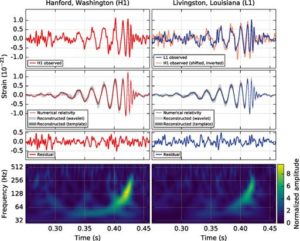
The year 2015 saw breakthroughs in two areas of astrophysics: radio astronomy and gravitational-wave astronomy.
The first ever detection by scientists of gravitational waves was described recently by scientist, Stephen Hawking, as confirming Einstein’s theory of General Relativity and astrophysical science based on that theory. The detection on September 14, 2015, was announced in February, 2016, by Advanced LIGO (Advanced Laser Interferometer Gravitational-Wave Observatory). The detection was said to fundamentally change science forever.
However, the revolutionary change is not that the direction of science is completely altered, but rather that what was only a prediction up to that point, (the last unproven theorem of General Relativity up to that point was the existence of gravitational waves), has been, for the first time ever, confirmed.
The ripple of that discovery is that not only has Einstein’s theory been confirmed; Hawking’s theory of black holes, and the related “big bang” theory of the universe’s beginning, are also felt by scientists to be confirmed.
In the wake of last week’s historic announcement of the discovery of gravitational waves by the Laser Interferometer Gravitational-Wave Observatory (LIGO), British physicist and black hole theorist Stephen Hawking was quick to congratulate the US-led collaboration, sharing his excitement for the historic news.
“These results confirm several very important predictions of Einstein’s theory of general relativity,” Hawking said in a BBC interview. “It confirms the existence of gravitational waves directly.”
ANALYSIS: We’ve Detected Gravitational Waves, So What?
As is becoming clear, the direct detection of these ripples in spacetime not only confirm Einstein’s famous theory of general relativity, they open our eyes to a previously “dark” universe. Astronomy uses the electromagnetic spectrum (such as visible light, X-rays, infrared) to study the universe, but objects that do not radiate in the electromagnetic spectrum will go unnoticed. But now we know how to detect gravitational waves, there could be a paradigm shift in how we detect and study some of the most energetic cosmic phenomena.
“Gravitational waves provide a completely new way of looking at the universe,” said Hawking. “The ability to detect them has the potential to revolutionize astronomy.”
Using LIGO’s twin observing stations located in Louisiana and Washington, physicists not only detected gravitational waves; the gravitational waves they detected had a very clear signal that closely matched theoretical models of a black hole merger some 1.3 billion light-years away. Already, from initial analysis of the black hole merger signal, Hawking has realized that the system seems to align itself with theories he developed in the 1970’s.
ANALYSIS: Hawking Tries to Find Black Hole’s Emergency Exit
“This discovery is the first detection of a black hole binary system and the first observation of black holes merging,” he said. “The observed properties of this system is consistent with predictions about black holes that I made in 1970 here in Cambridge.”
Read the rest of this analysis at news.discovery.com.
Image By Doug Wheller, via Wikimedia Commons, of Professor Stephen Hawking in Cambridge, August, 2008.
Gravitational wave image by Abbott, et al., via Wikimedia Commons:
LIGO measurement of gravitational waves. Shows the gravitational wave signals received by the LIGO instruments at Hanford, Washington (left) and Livingston, Louisiana (right) and comparisons of these signals to the signals expected due to a black hole merger event. Date 11 February 2016 (original upload date). Source B.?P. Abbott et al. (LIGO Scientific Collaboration and Virgo Collaboration). “Observation of Gravitational Waves from a Binary Black Hole Merger”.
To see the video of Steven Hawking discussing the above, visit the next page.



